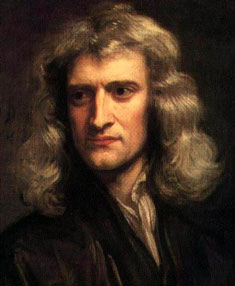A Christian world view, and in particular a plain understanding of Scripture and Adam’s Fall, was essential for the rise of modern science.
Published: 29 September 2009(GMT+10)
This is the pre-publication version which was subsequently revised to appear in Creation 32(4):32–36.
Portrait by Godfrey Kneller, Wikipedia.org

Sir Isaac Newton (1643–1727)
‘The philosophy of experimental science … began its discoveries and made use of its methods in the faith, not the knowledge, that it was dealing with a rational universe controlled by a creator who did not act upon whim nor interfere with the forces He had set in operation… It is surely one of the curious paradoxes of history that science, which professionally has little to do with faith, owes its origins to an act of faith that the universe can be rationally interpreted, and that science today is sustained by that assumption.’2But if atheism or polytheism is true, then there is no way to deduce from these belief systems that the universe is (or should be) orderly.
Furthermore, Genesis 1:28 gives us permission to investigate creation, unlike say animism or pantheism which teach that the creation itself is divine. And since God is sovereign, He was free to create as He pleased. So where the Bible is silent, the only way to find out how His creation works is to experiment, rather than to rely on man-made philosophies, as did the ancient Greeks. So no wonder that sociologist and author Rodney Stark affirmed:
“Science was not the work of western secularists or even deists; it was entirely the work of devout believers in an active, conscious, creator God.”3Furthermore, science requires that we can think rationally, and that results should be reported honestly, more teachings found in the Bible but do not follow from evolutionism.4
Science in the Middle Ages
While this period used to be called the “Dark Ages”, responsible historians recognize that it was far from dark. Rather, it was a period of great scientific advances, stemming from the logical thought patterns of the medieval Scholastic philosophers of the Church, and the extensive inventiveness and mechanical ingenuity developed in the monasteries. Small wonder that this period saw the development of water and wind power, spectacles, magnificent architecture, the blast furnace, and the stirrup.5An enormous advance in physical understanding was 14th-century logician John Buridan’s development of the concept of impetus, essentially the same as the modern concept of momentum. Previously, Aristotle’s followers argued that a moving object required a force to keep it moving, but Buridan proposed:
“…after leaving the arm of the thrower, the projectile would be moved by an impetus given to it by the thrower and would continue to be moved as long as the impetus remained stronger than the resistance, and would be of infinite duration were it not diminished and corrupted by a contrary force resisting it or by something inclining it to a contrary motion.”This is a forerunner of Isaac Newton’s First Law of Motion.
So it’s not surprising that James Hannam, who recently earned a Ph.D. on the History of Science from the University of Cambridge, UK, pointed out:
“During the Middle Ages, the Catholic Church actively supported a great deal of science, which it also kept control of when speculation could impinge on theology. Furthermore and contrary to popular belief, the Church never supported the idea that the earth was flat, never banned human dissection, never banned zero and certainly never burnt anyone at the stake for scientific ideas.”
“Popular opinion, journalistic cliché and misinformed historians notwithstanding, recent research has shown that the Middle Ages were a period of enormous advances in science, technology and culture. The compass, paper, printing, stirrups and gunpowder all appeared in Western Europe between AD 500 and AD 1500.”6
Scientific jump after the Reformation
While Europe in the Middle Ages had a Judeo-Christian world view, it took the Reformation to recover specific biblical authority. With this came the recovery of a plain or historical grammatical understanding of the Bible, recovering the understanding of the New Testament authors and most of the early Church Fathers. This turned out to have a huge positive impact on the development of modern science. This is so counter to common (mis)understanding, yet it is well documented by Peter Harrison, then a professor of history and philosophy at Bond University in Queensland, Australia (and now Andreas Idreos Professor of Science and Religion at the University of Oxford):“It is commonly supposed that when in the early modern period individuals began to look at the world in a different way, they could no longer believe what they read in the Bible. In this book I shall suggest that the reverse is the case: that when in the sixteenth century people began to read the Bible in a different way, they found themselves forced to jettison traditional conceptions of the world.”7As Prof. Harrison explained:
“Strange as it may seem, the Bible played a positive role in the development of science. …
Had it not been for the rise of the literal interpretation of the Bible and the subsequent appropriation of biblical narratives by early modern scientists, modern science may not have arisen at all. In sum, the Bible and its literal interpretation have played a vital role in the development of Western science.”8Stephen Snobelen, Assistant Professor of History of Science and Technology, University of King’s College, Halifax, Canada, writes in a similar vein, and also explains the somewhat misleading term “literal interpretation”:
“Here is a final paradox. Recent work on early modern science has demonstrated a direct (and positive) relationship between the resurgence of the Hebraic, literal exegesis of the Bible in the Protestant Reformation, and the rise of the empirical method in modern science. I’m not referring to wooden literalism, but the sophisticated literal-historical hermeneutics that Martin Luther and others (including Newton) championed.”9And Prof. Snobelen explains the reason why: scientists started to study nature in the same way they studied the Bible. I.e. just as they studied what the Bible really said, rather than imposed outside philosophies and traditions upon it, they likewise studied how nature really did work, rather than accept philosophical ideas about how it should work (extending their allegorizing readings of Scripture to the natural world8).
“It was, in part, when this method was transferred to science, when students of nature moved on from studying nature as symbols, allegories and metaphors to observing nature directly in an inductive and empirical way, that modern science was born. In this, Newton also played a pivotal role. As strange as it may sound, science will forever be in the debt of millenarians and biblical literalists.”9
Belief in the Fall of Adam: how it inspired science
Image Wikipedia.org

Francis Bacon (1561–1626)
“New [sic] literal readings of the creation narratives in Genesis provided 17th century thinkers with powerful motivating images for pursuing the natural sciences.
“Adam was thought to have possessed a perfect knowledge of all sciences, a knowledge lost to posterity when he fell from grace and was expelled from the Garden of Eden. The goal of 17th century scientists such as Francis Bacon and his successors in the Royal Society of London was to regain the scientific knowledge of the first man. Indeed, for these individuals, the whole scientific enterprise was an integral part of a redemptive enterprise that, along with the Christian religion, was to help restore the original race to its original perfection. The biblical account of the creation thus provided these scientists with an important source of motivation, and in an age still thoroughly committed to traditional Christianity, the new science was to gain social legitimacy on account of these religious associations.”8
“For many champions of the new learning in the seventeenth century, the encyclopaedic knowledge of Adam was the benchmark against which their own aspirations were gauged. …
“The experimental approach, I shall argue, was deeply indebted to Augustinian views about the limitations of human knowledge in the wake of the Fall, and thus inductive experimentalism can also lay claim to a filial relationship with the tradition of Augustinianism.”10
Objection
Some atheopaths admit that science was in effect a child of Christianity, but now claim that it’s time science grew up and cut the apron strings. However, none other than former UK Prime Minister Margaret Thatcher answered that type of claim:“I think back to many discussions in my early life when we all agreed that if you try to take the fruits of Christianity without its roots, the fruits will wither. And they will not come again unless you nurture the roots.
“But we must not profess the Christian faith and go to Church simply because we want social reforms and benefits or a better standard of behaviour; but because we accept the sanctity of life, the responsibility that comes with freedom and the supreme sacrifice of Christ expressed so well in the hymn:
“‘When I survey the wondrous Cross, On which the Prince of glory died, My richest gain I count but loss, And pour contempt on all my pride.’”11
Summary
- Atheopaths often disparage the Bible, especially its account of creation. Yet …
- Science requires certain presuppositions to work at all, and these are found in the Bible.
- Europe in the Middle Ages, with its general Christian world view, advanced greatly in science and technology.
- The Reformation, with its emphasis on the authority of Scripture and a historical-grammatical understanding, led to a great leap forward in science as such methods were carried over into the study of nature.
- Belief in a literal first man Adam and his Fall inspired science as a means to rediscover knowledge Adam had before the Fall.
- It is futile to expect continued fruits of the scientific enterprise while undermining the roots in biblical Christianity.
Related Articles
Further Reading
References
- Leading misotheist Richard Dawkins often calls theistic religion a ‘virus of the mind’, which would make it a kind of disease or pathology, and parents who teach it to their kids are, in Dawkins’ view, supposedly practising mental child abuse. But the sorts of criteria Dawkins applies makes one wonder whether his own fanatical antitheism itself could be a mental pathology—hence, “atheopath”. Return to text.
- Eiseley, L., Darwin’s Century: Evolution and the Men who Discovered It, Doubleday, Anchor, New York, 1961. Return to text.
- Stark, R., For the Glory of God: How monotheism led to reformations, science, witch-hunts and the end of slavery, Princeton University Press, 2003; see also review by Williams A., The biblical origins of science, Journal of Creation 18(2):49–52, 2004; <creation.com/stark>. Return to text.
- Sarfati, J., Why does science work at all? Creation 31(3):12–14, 2009; see earlier version on this site. Return to text.
- Carroll, V., and Shiflett, D., Christianity on Trial: Arguments Against Anti-Religious Bigotry, ch. 3, Encounter Books, 2001; see review by Hardaway, B. and Sarfati, J., Journal of Creation 18(3):28–30, 2004 <creation.com/trial>. Return to text.
- See Hannam, J., God’s Philosophers: How the Medieval World Laid the Foundations of Modern Science, 2007; <http://jameshannam.com/Godsphilosophers.pdf>. Return to text.
- Harrison, P., The Bible, Protestantism and the rise of natural science, Cambridge University Press, 2001; see review by Weinberger, L., J. Creation 23(3):21–24, 2009 (in press). Return to text.
- Harrison, P., The Bible and the rise of science, Australasian Science 23(3):14–15, 2002. Return to text.
- Snobelen, S., Isaac Newton and Apocalypse Now: a response to Tom Harpur’s “Newton’s strange bedfellows”; A longer version of the letter published in the Toronto Star, 26 February 2004; isaacnewton.ca/media/Reply_to_Tom_Harpur-Feb_26.pdf. Return to text.
- Harrison, P., The Fall of Man and the Foundations of Science, Cambridge University Press, 2007, introduction. Return to text.
- Thatcher, M., Christianity and Wealth, Speech to the Church of Scotland General Assembly, 21 May 1988. Return to text.
No comments:
Post a Comment